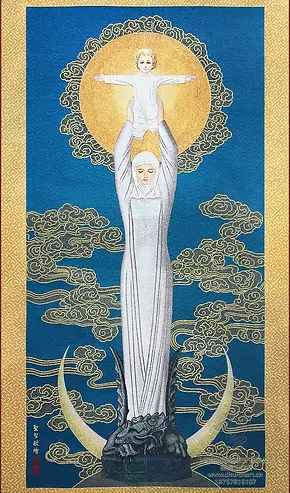When State Interferes with Religion: Friction Between China and the Catholic Church

"Image of Our Lady of Sheshan Help of Christians on the exterior dome of the Sheshan Basilica." Source: Weibo, published by Wikimedia Commons
"On many occasions the Synod Fathers turned their thoughts to the Catholic Church in Mainland China and prayed that the day may soon come when our beloved Chinese brothers and sisters will be completely free to practise their faith in full communion with the See of Peter and the universal Church. To you, dear Chinese brothers and sisters, I make this fervent exhortation: never allow hardship and sorrow to diminish your devotion to Christ and your commitment to your great nation."
Per Article 36 of the Chinese Constitution:
"Citizens of the People’s Republic of China enjoy freedom of religious belief.
No State organ, public organization or individual may compel citizens to believe in, or not to believe in, any religion; nor may they discriminate against citizens who believe in, or do not believe in, any religion.
The State protects normal religious activities. No one may make use of religion to engage in activities that disrupt public order, impair the health of citizens or interfere with the educational system of the State.
Religious bodies and religious affairs are not subject to any foreign domination."
It is unsurprising that China's government not only holds increased control in the realm of economics and politics as compared to the United States, but within religion as well. As noted above, freedom of religion is a recognized right by the Chinese constitution, though one might quickly come to question the validity and enforcement of this statement given the recent mass targeting of Uighur Muslims in the Xinjiang Autonomous Region. This freedom is subject to relatively broad limitations, such as the stipulation that religious activities must not "disrupt public order" nor "interfere with the educational system of the State".
A context important to consider is the principle of separation of Church and State. This tenet is a cornerstone of American democracy, enshrined in the First Amendment of the Constitution. This principle ensures that religious institutions and government entities operate independently, ultimately promoting a pluralistic society where diverse beliefs coexist without undue governmental interference.
Contrastingly, China's approach to religion reflects a fundamentally different worldview, where state control extends into religious practices, exemplified by its relationship with the Catholic Church.
In the United States, religious organizations enjoy significant autonomy, operating free from government dictates and contributing to the public sphere without fear of retribution. This separation allows for a distinct relationship between religion and politics, where faith-based perspectives can inform public debate without directly influencing governmental decisions. For example, American religious groups can advocate for social issues, participate in public policy discussions, and maintain independent religious practices. China, however, embodies a contrasting model: The Chinese government maintains tight control over religious practices through institutions like the Chinese Catholic Patriotic Association (CPA), which oversees and regulates all religious activities. This state-sanctioned organization ensures that the Catholic Church in China aligns with government policies and suppresses foreign influence. The Chinese model reflects a broader strategy of maintaining state control and unity, where dissenting voices, including those from religious institutions, are carefully managed to prevent challenges to the Communist Party’s authority. The divergence in these approaches reveals deeper philosophical and political differences. In the US, the separation of Church and State is designed to protect religious freedom as a fundamental right, allowing a multiplicity of beliefs to thrive within a democratic framework. This separation facilitates a balance of power where religious institutions can influence societal values without directly engaging in political control.
The CCP's integration of strict religious control into its governance strategy illustrates the broader commitment to centralized authority and political stability, upholding the premise that party supremacy trumps all. This holds particularly true following the rise of Xi Jinping who, unlike his predecessors, has reverted to draconian-style policies to promote party unity and control. The motives behind doing so are plentiful and complex, yet among the key reasons includes the CCP's broader uncertainty in progressing the nation as the effects of Deng Xiaoping's "Reform and Opening Up" era lose their traction in face of a vastly different society. The government’s oversight of religious institutions, including the Catholic Church, truly illustrates a broader emphasis on maintaining state unity and suppressing potential sources of dissent. This model reflects a worldview where political control is prioritized over individual freedoms. Thus, the comparison between the American and Chinese approaches to Church-State separation not only highlights the practical implications for religious practice and political influence but also reveals fundamental differences in governance philosophies. In essence, the US embraces a model of religious autonomy within a democratic context, while China’s approach unsurprisingly demonstrates a commitment to centralized control.

“Chinese worshippers attend Christmas Eve Mass at a Catholic church in Beijing during 2015.” Source: Wang Zhao/AFP/Getty Images, published by Evan Rees/Stratfor